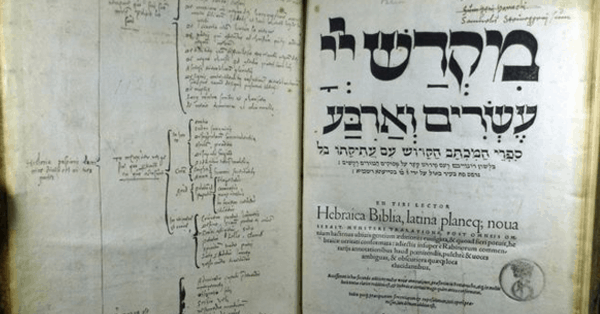
Why should we care about the discovery of John Knox’s Bible? In this episode of 5 Minutes in Church History, Dr. Stephen Nichols explains.

An article written by a librarian at the University of Glasgow in Scotland and published on the library’s website attracted worldwide attention in 2016. That probably doesn’t happen very often. The article, published on September 21, 2016, was about a Hebrew Bible, one with the original Hebrew on one side and a Latin translation next to it. It was published in Basel, Switzerland, in 1546.
We must pause here and recognize what a monumental feat this Bible was. It would have to have been typeset by hand, and in Hebrew, there are very intricate letters and also significant marks called vowel points above and below the lines. So, this would have taken a skilled engraver who engraved the type, then a very skilled typesetter, and then skilled proofreaders, just to publish this Bible in the first place. Basel at the time was one of the best publishing cities in Europe. In fact, when Calvin was first converted, he went to Basel and spent a few months there so that he could learn the book trade and the ins and outs of publishing because he knew what a crucial role books would play in the Reformation.
This Bible is very special, not only because it’s a Hebrew and Latin text published in 1546 but also because of its owner. If you were to turn over the title page, you would see this signature: Jo. Knox. It is dated 1561. This was John Knox’s Bible. You can imagine the excitement of that librarian at the University of Glasgow when they discovered that they had John Knox’s Bible. And so, now, you can understand why an article published on the library’s website got so much attention.
This is a fascinating book. It gives us some insight into the Reformation. The Reformers were, first of all, people of the book. They were about restoring preaching. They were about restoring the Bible to the center of the church’s life and about restoring biblical authority as the sole infallible guide for the church. What this shows us is that the Reformers not only cared about the Bible, they also studied the Bible.
One of the Knox scholars at the University of Edinburgh talks about how Knox was introduced to the great Hebraist Anthony Gilby in Geneva. Gilby and Knox became close friends as they were exiled together during the reign of Bloody Mary. While Knox was in Geneva with Gilby, he learned Hebrew. And it was probably there in Geneva that he picked up this Bible, and when he got back to Scotland he signed and dated it.
Knox studied this book because it is the Word of God in its original language. This was what Knox was about: knowing and preaching the Word of God. And this was what Knox wanted to restore to the life of the church.
We don’t know what happened to the rest of John Knox’s books. Many of them were lost. We can hope that this will be the first of many such serendipitous discoveries of Knox’s books and that we will be seeing more articles from more Scottish libraries on Knox’s books.
Stay connected with 5 Minutes in Church History by getting the weekly podcast on iTunes, SoundCloud, or via RSS. You can also subscribe to the blog via RSS and follow us on Twitter and Facebook.
(This podcast is by Ligonier Ministries. Discovered by e2 media network and our community — copyright is owned by the publisher, not e2 media network, and audio is streamed directly from their servers.)